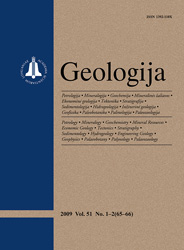 ISSN 1392-110X ISSN 2029-056X (online) |
2010 m. Nr. 1-4 Loess-soil sequences as a source of climatic proxies: an example from SW Poland
Loess in SW Poland occurs in several isolated patches which differ in sediment thickness, stratigraphy and physical properties. The most representative loess sequences provide a record of climate changes for the Last Glacial cycle (Eemian–Weichselian). A representative loess section in SW Poland can be subdivided into four units: two polygenetic fossil soil sets and two, usually calcareous, loess units. On the top of the younger loess unit, recent soil has formed. Differences in the physical properties of these units result from the climatic conditions during sedimentation, which infl uenced the intensity of pedogenic processes and the rate of loess accumulation. Combined climatic proxies obtained from palaeosols, lithological composition and periglacial structures enable reconstruction of Late Pleistocene climate conditions as well as of proper correlations between continental, marine and ice-core events. Keywords: loess–palaeosol sequence, lithostratigraphic units, proxy data, climate change, Late Pleistocene, SW Poland |
Issues:
2011 - Vol.53 No. 1, No. 2, No. 3 2010 - Vol.52 No. 1-4 2009 - Vol.51 No. 1-2, No. 3-4 2008 - Vol.50 No. 1, No. 2, No. 3, No. 4, No. Priedas 2007 No. 1, No. 2, No. 3, No. 4 2006 No. 1, No. 2, No. 3, No. 4 2005 No. 1, No. 2, No. 3, No. 4 2004 No. 1, No. 2, No. 3, No. 4 2003 No. 1, No. 2, No. 3, No. 4 2002 No. 1, No. 2, No. 3, No. 4 2001 No. 1, No. 2, No. 3, No. 4 |